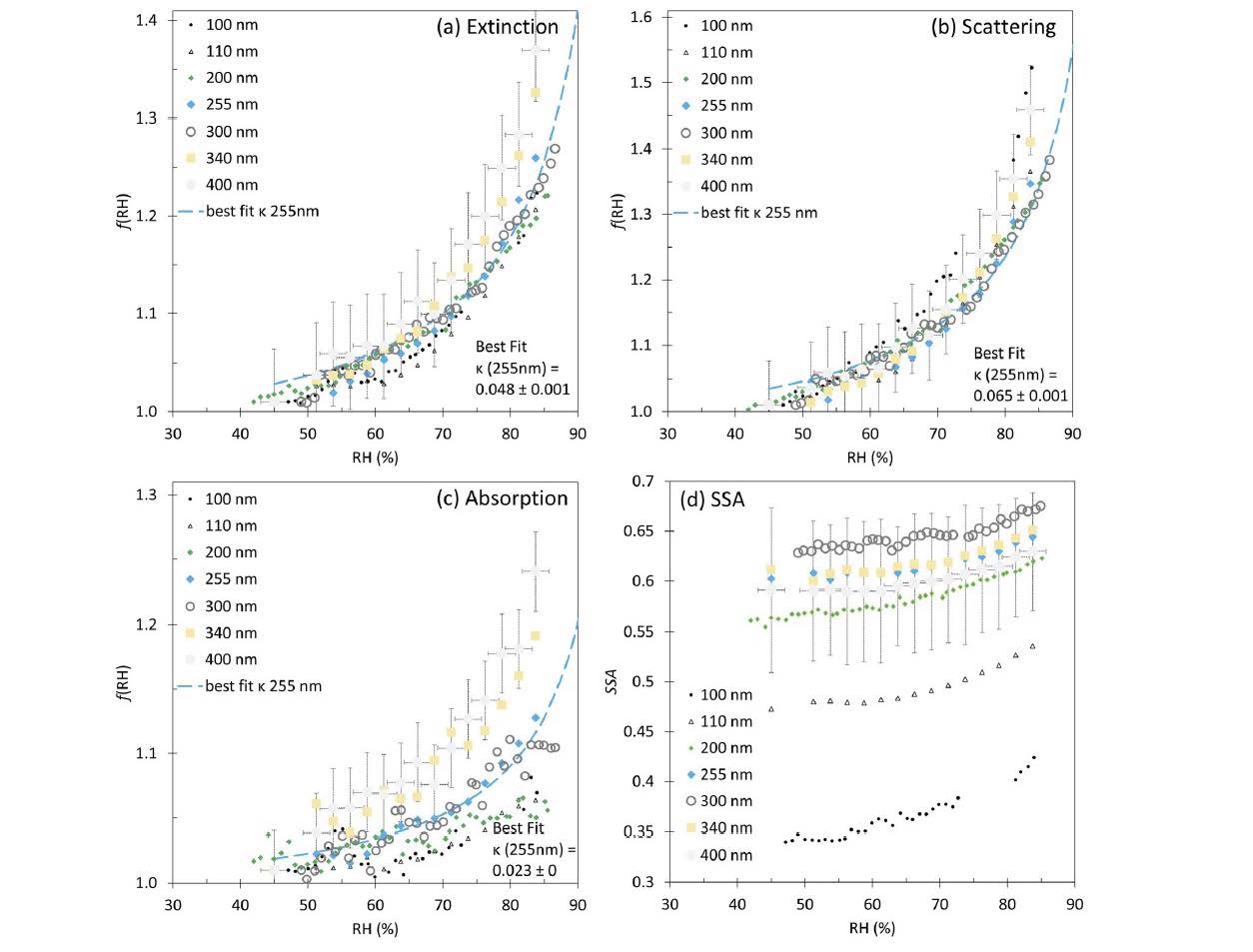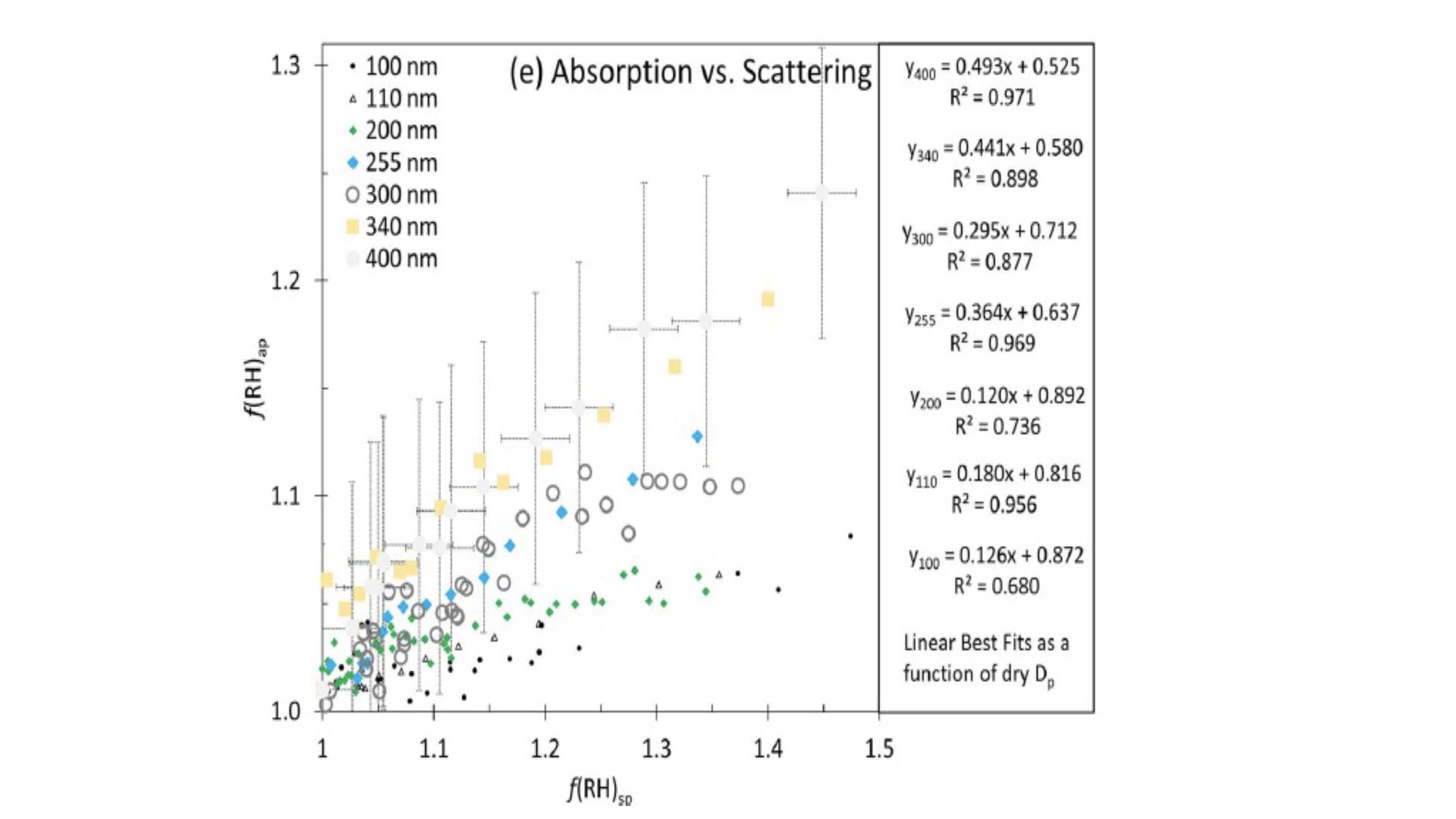New instrument probes humidity effect on aerosol light absorption
Submitter
Dubey, Manvendra K.
— Los Alamos National Laboratory
Area of Research
Aerosol Properties
Journal Reference
Carrico C, T Capek, K Gorkowski, J Lam, S Gulick, J Karacaoglu, J Lee, C Dungan, A Aiken, T Onasch, A Freedman, C Mazzoleni, and M Dubey. 2021. "Humidified single-scattering albedometer (H-CAPS-PM ): Design, data analysis, and validation." Aerosol Science and Technology, 55(7), 10.1080/02786826.2021.1895430.
Science

Figure 1. Comparison of f(RH) (where “dry” RH < 40%) for pure nigrosin measured with H-CAPS-PMSSA and corrected for truncation, for (a) rep, (b) rsp, (c) rap, and (d) SSA(RH) f(RH)ap versus f(RH)sp. Representative best-fit optical k-lines are shown for dry Dp ¼ 255 nm. Representative error bars show the standard deviation of the given f(RH) parameter and ±2% RH sensor accuracy. From journal.

Figure 2. f(RH)ap versus f(RH)sp support simple parameterizations for use in climate models. Representative best-fit optical k-lines are shown for dry Dp ¼ 255 nm. Representative error bars show the standard deviation of the given f(RH) parameter and ±2% RH sensor accuracy. From journal.
Soot particles can absorb more sunlight when they are coated with water as they grow into cloud drops. This enhanced absorption that is included in climate and cloud models increases soot’s warming directly by solar absorption and indirectly by promoting cloud evaporation is unvalidated. Our new optical instrument allows robust observations of humidity-driven absorption increase for field studies to fill this gap.
Impact
While most aerosols cool climate by scattering sunlight, soot and brown carbon warm climate by absorbing sunlight. Furthermore, water coatings on absorbing aerosols can enhance this absorption by lensing by a factor of two. While this effect is included in climate models and increases the warming by absorbing aerosols, it is hard to measure and has not been observed systematically or reliably in the field.
Summary
Wet soot in smoke clouds absorbs more sunlight than dry soot in climate models. However, this enhanced absorption by humidity is difficult to measure because laser-based techniques heat the particles and evaporate the water, which corrupts observations. Our new instrument circumvents this problem by developing a gentler technique that uses a low-power, light-emitting diode to measure water’s effect on scattering and absorption by wildfire smoke and hence its growth. By sampling the smoke and scanning the humidity from dry to very humid conditions while measuring its optical properties, the instrument mimics what happens during cloud and rain formation, and the effects of water are measured in vivo. Lab experiments show for the first time that water coatings on black soot-like material enhance light absorption by 20 percent. Furthermore, the absorption enhancement correlates well with scattering enhancement, offering simple empirical parameterizations. The instrument will be used to monitor the increase in absorption by humidity in wildfire smoke at Los Alamos as well as for urban soot in convective storms for ARM’s TRACER-CAT campaign in Houston.
Keep up with the Atmospheric Observer
Updates on ARM news, events, and opportunities delivered to your inbox
ARM User Profile
ARM welcomes users from all institutions and nations. A free ARM user account is needed to access ARM data.


















